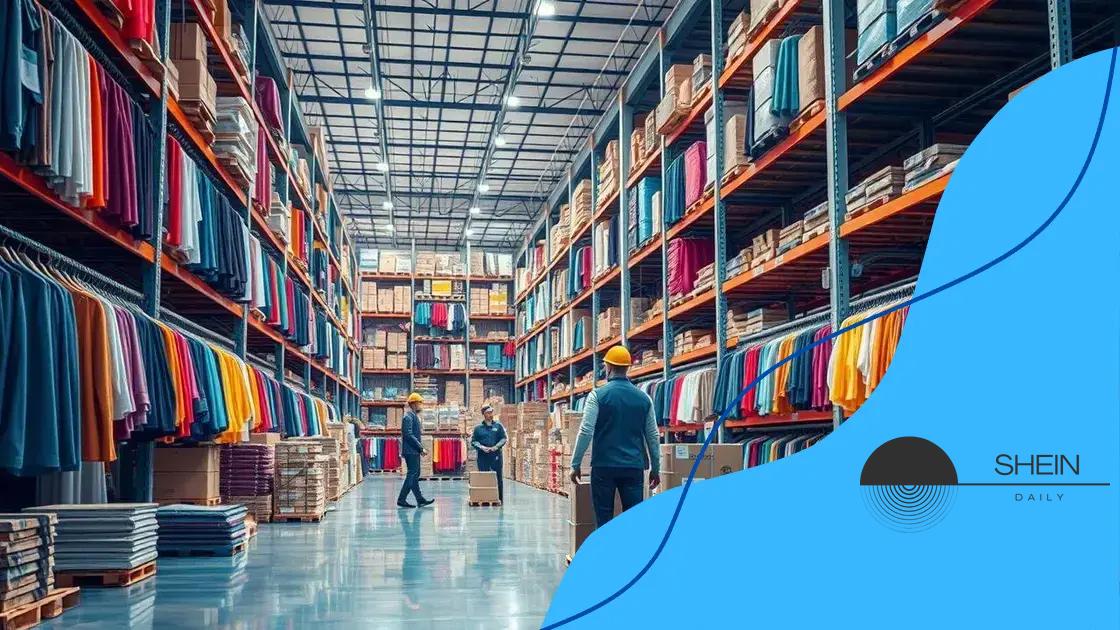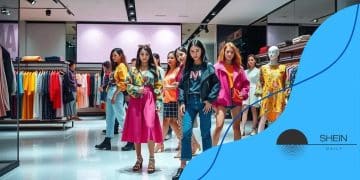Shein’s growth during global supply chain challenges

Shein’s growth during global supply chain challenges is driven by its adaptability, technological innovations, and focus on sustainability, enabling it to maintain competitiveness in the fast-fashion market.
Shein’s growth during global supply chain challenges is a fascinating case study of resilience. How did a fast-fashion giant navigate these turbulent waters? Let’s dive into their journey.
The impact of supply chain disruptions on fashion
The impact of supply chain disruptions on fashion is significant and multifaceted. These challenges have shaped how brands operate and connect with consumers.
Immediate Consequences
When supply chains falter, the fashion industry feels the ripple effects immediately.
- Production delays that affect seasonal collections.
- Increased costs for sourcing materials.
- Challenges in meeting consumer demand.
Fashion brands often find themselves scrambling to find alternative suppliers. This unpredictability can lead to partial collections being released or even cancellations of entire lines. For shoppers, this translates into fewer options and longer wait times for products.
Long-Term Effects
Over time, continuous supply chain disruptions can alter the landscape of the industry.
- A shift towards more sustainable practices.
- An emphasis on local sourcing to reduce risks.
- Increased investment in technology for better supply chain management.
Brands are not just focused on recovery; they are also rethinking their business models to build resilience. By prioritizing flexibility and sustainability, the industry is evolving to cope with future challenges more effectively.
Understanding these impacts helps consumers appreciate the complexities behind each garment. As the fashion world navigates these disruptions, brands that adapt creatively will likely lead the way.
Shein’s adaptive strategies during challenges
Shein’s adaptive strategies during challenges have played a crucial role in their remarkable growth. Facing numerous disruptions, this brand quickly evolved to meet new demands.
Flexibility in Supply Chain
One key strategy has been the flexibility in their supply chain. Shein has developed a model that allows for quick adjustments in production and sourcing.
- Rapid response to fashion trends.
- Diverse supplier networks to mitigate risks.
- Efficient inventory management to reduce excess stock.
These methods enable Shein to launch new styles quickly and efficiently, keeping up with the fast-paced fashion world. This agility is a significant advantage in an industry where trends change rapidly.
Leveraging Technology
Another important aspect is Shein’s commitment to technology. They leverage advanced data analytics to understand consumer preferences better.
- Using algorithms to predict trending styles.
- Implementing AI for inventory optimization.
- Enhancing online shopping experiences through personalized recommendations.
By utilizing these technologies, Shein not only improves operational efficiency but also connects deeply with its audience. This approach cultivates a loyal customer base that appreciates tailored shopping experiences.
In addition to technology, Shein has embraced sustainable practices as part of their strategy. By sourcing environmentally friendly materials and promoting recycling, they respond to the growing consumer demand for sustainability. These efforts position the brand favorably in the market, appealing to environmentally conscious shoppers.
Consumer behavior shifts and their role

Consumer behavior shifts and their role in the fashion industry are profound and continuously evolving. Understanding these changes helps brands adapt and meet customer needs effectively.
Rise of Online Shopping
One major shift is the increase in online shopping. More consumers prefer the convenience of shopping from home rather than visiting physical stores.
- Access to a wider range of products.
- Ability to compare prices easily.
- Convenience of home delivery.
This transformation has pushed fashion brands to invest in robust e-commerce platforms. As a result, they are enhancing user experiences through intuitive designs and fast shipping options.
Demand for Transparency
Another important change is the growing demand for transparency. Consumers want to know where their clothing comes from and the methods used in production.
- Interest in ethical sourcing of materials.
- Desire for fair labor practices.
- Willingness to support sustainable brands.
This push for transparency influences consumer loyalty. Brands that share their sustainability efforts and ethical practices often gain a competitive edge in the market.
Additionally, social media plays a huge role in shaping consumer tastes. Influencers and peers regularly share their shopping experiences and preferences, which can significantly impact buying decisions. This interconnectedness means that brands must maintain a strong online presence and engage authentically with their audiences.
Ultimately, the shifts in consumer behavior challenge fashion brands to innovate continually. By tapping into these trends, companies can better align their offerings with what today’s shoppers expect and value.
Technological innovations fueling Shein’s success
Technological innovations fueling Shein’s success are critical to its rapid growth and ability to adapt in a competitive market. By embracing advanced technologies, Shein has enhanced its operational efficiency and customer engagement.
Data-Driven Decisions
One of the primary innovations is the use of data analytics. Shein employs sophisticated algorithms to analyze consumer behavior and preferences.
- Tracking shopping patterns to identify trends.
- Utilizing data to optimize inventory levels.
- Making informed decisions about product launches.
This data-driven approach allows them to react quickly to changes in the market and improve customer satisfaction. Understanding what customers want enables Shein to deliver relevant products at lightning speed.
Artificial Intelligence in Design
Another key factor is the integration of artificial intelligence into their design process. AI simplifies the product development cycle.
- Generating styles based on current fashion trends.
- Predicting what colors and styles will be popular.
- Reducing the time from concept to market.
This innovation not only speeds up production but also aligns the company’s offerings with consumer demands, ensuring that the latest styles reach shoppers promptly.
Additionally, Shein uses AI for personalized shopping experiences. This technology helps to recommend products tailored to individual customers based on their previous interactions. Such personalization fosters a deeper connection with the brand and can lead to increased sales.
Moreover, Shein’s investment in logistics technology enhances their supply chain efficiency. By optimizing shipping methods and delivery processes, they minimize delays while ensuring that customers receive their orders quickly. This operational edge strengthens Shein’s reputation as a speedy and reliable brand.
Future projections for Shein in a changing market
Future projections for Shein in a changing market are focused on adapting to new consumer habits and expanding their reach. As the fashion landscape evolves, Shein is well-positioned to respond to these trends and leverage new opportunities.
Emphasis on Sustainability
One significant trend is the emphasis on sustainability. Consumers are becoming more environmentally conscious, leading brands to adopt eco-friendly practices.
- Investing in recycled materials.
- Implementing sustainable manufacturing processes.
- Promoting responsible consumption among customers.
Shein can tap into this growing demand by enhancing their sustainability initiatives. By becoming a leader in eco-friendly fashion, they can attract a dedicated customer base that values conscious shopping.
Expansion into New Markets
Another projection is Shein’s potential expansion into new global markets. As the brand gains recognition, opportunities in emerging economies are on the horizon.
- Targeting regions with growing middle-class populations.
- Adapting marketing strategies for local preferences.
- Utilizing regional influencers to boost brand visibility.
This expansion not only increases revenue but also diversifies their customer portfolio, making them less vulnerable to market fluctuations.
Moreover, Shein’s ongoing investment in technology will play a critical role in their future. With advancements in artificial intelligence and machine learning, they can personalize experiences and streamline operations even further. By harnessing data effectively, Shein will refine product offerings based on detailed consumer insights.
As they look to the future, Shein’s ability to innovate and adapt will be key to maintaining their competitive advantage. Overall, the brand is poised to thrive in a landscape that continually shifts toward greater sustainability and digital engagement.
FAQ – Frequently Asked Questions about Shein’s Growth and Strategies
How has Shein adapted to global supply chain challenges?
Shein has utilized flexibility in its supply chain, allowing for quick adjustments in production and sourcing to meet demand.
What role does technology play in Shein’s success?
Technology, especially data analytics and AI, helps Shein optimize inventory, predict trends, and personalize shopping experiences for customers.
How is Shein addressing consumer demand for sustainability?
Shein is investing in recycled materials and promoting responsible consumption to align with the growing consumer preference for sustainable fashion.
What are Shein’s plans for future expansion?
Shein aims to expand into new markets, focusing on regions with growing middle-class populations while adapting their marketing strategies to local preferences.





